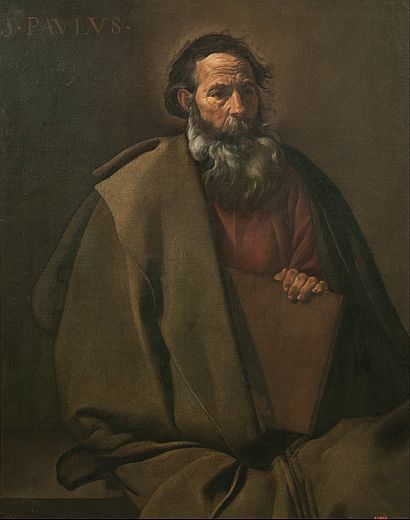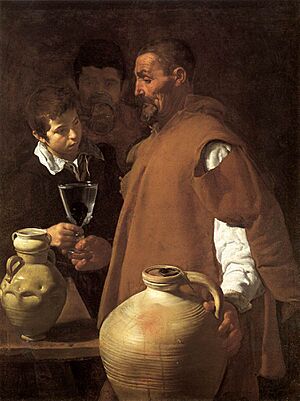Saint Paul (Velázquez) facts for kids
Quick facts for kids Saint Paul |
|
|---|---|
 |
|
| Artist | Diego Velázquez |
| Year | circa 1619 |
| Medium | Oil on canvas |
| Dimensions | 99.5 cm × 80 cm (39.2 in × 31 in) |
| Location | Museu Nacional d'Art de Catalunya, Barcelona |
| Website | http://www.museunacional.cat/en/colleccio/saint-paul/diego-velazquez/024242-000 |
Saint Paul (Spanish: San Pablo) is a famous painting by Diego Velázquez. He was a very important Spanish artist. Velázquez painted this artwork around 1619. It was an early work in his career. The painting is now in the Museu Nacional d'Art de Catalunya in Barcelona, Spain.
In the painting, you see Saint Paul sitting down. He is holding a large book. This book is often thought to be a Gospel book. Velázquez was greatly influenced by the artist Caravaggio when he painted this.
Contents
What the Painting Shows
This painting was made using oil paints on a canvas. Velázquez was from Seville, Spain. He was very good at painting portraits, which are pictures of people. He made the man in the painting look very real.
Saint Paul wears a wide robe. The folds in the robe look almost like a sculpture. The painting uses strong, dramatic light. This light makes Saint Paul stand out against a dark background. This style is called Tenebrism. Velázquez often used dark, earthy colors. This helped him make the figures look natural and real.
Saint Paul is sitting on a stone block. This block blends into the background. His left hand holds a thick book. Velázquez hid most of Saint Paul's legs and hands under the robe. This might have been to hide parts he found hard to paint.
An art expert named José López-Rey said Saint Paul's head is "sharply drawn." He also noted that the painting looks "somewhat rubbed and darkened." These are common features in Velázquez's early works.
Saint Paul's Appearance
The New Testament tells the story of Paul. He was traveling to Damascus when he saw a bright light. Jesus appeared to him and made him blind. Three days later, Paul could see again. He then started teaching Christianity to people.
In this painting, Saint Paul wears a large brown robe. This robe might show his journey from the Holy Land to Damascus. The robe is loose and thick. It has many creases, making the fabric look heavy. Underneath, he wears a reddish-brown tunic.
Saint Paul is usually shown with a long beard and brown hair. He often has a bald forehead. These features suggest he is wise and learned. However, Velázquez painted Saint Paul with black hair. It has a little gray in it, which is unusual for this figure. Saint Paul's eyes have a blank stare. This might show his temporary blindness from the story.
In the top-left corner of the painting, you can see the words S. PAVLVS. This means "Saint Paul" in Latin. He is shown without a sword, which is one of his usual symbols. A sword often represents his death as a martyr.
A soft glow, or halo, is around Saint Paul's head. This shows he is holy and has been made a saint. The painting also makes you think of wise thinkers. These were often painted by artists like José de Ribera. Velázquez chose to show Saint Paul holding a book. This was different from how he was usually painted. The Gospel book shows that Saint Paul was an apostle. He helped spread the Christian religion a lot.
Painting's History
Saint Paul was painted around 1619. Velázquez moved from Seville in 1623. He became the official painter for King Philip IV in Madrid.
In 1921, an art expert named August Mayer said this painting was by Velázquez. This painting and another one of Saint Thomas are similar. The Saint Thomas painting is in the Musée des Beaux-Arts d'Orléans. Experts believe both paintings were once in a monastery in Seville.
Art historian Xavier Bray thinks these two paintings might be part of a series. Velázquez may have painted portraits of all twelve apostles. He would have done this while he was still in Seville. The other paintings in the series are now lost.
Velázquez was very influenced by Caravaggio when he was young. The painting of Saint Paul is important. It helps us understand how Caravaggio's realistic style affected art in Spain.
Velázquez's Painting Style
When Velázquez was young, he was inspired by books and his home country. As he became a more experienced painter, he kept using colors and things he saw in nature. He wanted people to see his subjects exactly as he saw them. So, he painted figures in a very realistic way. His paintings have a "quality of immortal freshness."
Velázquez was always a realist. He learned from Caravaggio and Italian Renaissance painters. He used both rough and smooth brushstrokes. An expert, José López-Rey, said his brushwork was more like Titian's than Caravaggio's.
Velázquez was different from other painters of his time. He did not usually plan his paintings carefully. He also did not make sketches beforehand. Instead, he studied his models. He drew everything just by looking. By the time Velázquez was thirty, he was very skilled in realism. He did not change his painting style after that.
In his early career, Velázquez painted two main types of works. One type was called bodegones. This term refers to paintings of "food, drink, or tableware." The second type was figure paintings. He made these between 1618 and 1622. These paintings focused on human feelings and expressions. Saint Paul is an example of this style. It clearly shows a serious human emotion.
Only about twenty of Velázquez's early works have been found. But it is clear that he "enjoyed painting portraits." Many of his early paintings show a "unifying religious undertone." This shows his strong Catholic faith throughout his life.
Other Related Artworks
In 1618, Velázquez lived in Seville. There, people called watersellers walked the streets. Between 1618 and 1620, Velázquez painted The Waterseller of Seville.
Art historian Peter Cherry thinks Velázquez used a real person as a model for this painting. Velázquez liked to paint ordinary subjects. Cherry believes the person in The Waterseller of Seville looks like the Saint Paul in the 1619 painting. He thinks Velázquez used the same model for both artworks.
See also
 In Spanish: San Pablo (Velázquez) para niños
In Spanish: San Pablo (Velázquez) para niños
- List of works by Diego Velázquez


